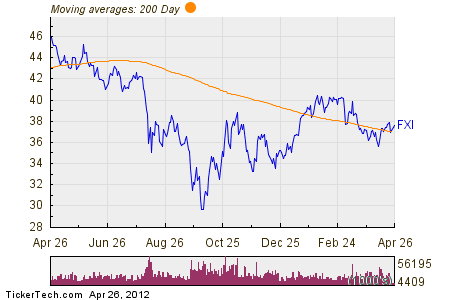IShares FTSE China 25 Index Fund (FXI)
Post on: 22 Апрель, 2015 No Comment

*As of 7/22/2011. **As of 7/6/2011
FXI is one of the earliest China ETFs to hit the market, and still remains one of the most popular ways for establishing exposure to the Chinese economy. FXI has close to $7 billion in assets, and more than 16 million shares trade hands every day. But FXI is not without its flaws; for investors seeking long-term China exposure, there are much better options available than this iShares ETF.
Under The Hood
It may be a mistake to assume that the massive size of FXI reflects its superiority as a means of establishing exposure to Chinese stock markets. While this ETF is useful in certain circumstances, the nature of the underlying portfolio limits its usefulness to those looking to build a long-term, buy-and-hold portfolio.
The first potential drawback is the shallow nature of the portfolio. As the name suggests, FXI has only about 25 components at any one time. That represents only a very small portion of the Chinese equity market, and results in some significant concentrations in individual stocks that increase company-specific risk. By comparison, ECNS holds more than 300 individual stocks, and GXC invests in more than 150.
Also of concern is the sector breakdown. Almost half of FXI’s portfolio consists of financial stocks, a huge weighting to afford to any one industry. Telecoms, energy firms, and materials companies account for much of the remainder, leaving little room for consumer companies, health care stocks, or technology firms. FXI overlooks some of the promising sectors of the Chinese economy entirely, a bias that may be less than ideal for those looking to achieve broad-based exposure to China.
It should also be noted that many of FXI’s components are large and mega cap stocks, and that the Chinese government holds positions in many of the component companies. For investors looking to tap into the true growth potential of China, it’s important to include smaller companies and allocations to the consumer, health care, and technology companies.
Finally, it is important to consider that all of the component companies in the underlying index trade on the Hong Kong Stock Exchange, resulting in limited “pure play” exposure to smaller companies in the Chinese economy (as well as exposure to the Chinese currency).
Pros
The biggest advantage of FXI is the unparalleled liquidity. More than 16 million shares change hands every day; the average daily volume corresponds to about 10% of the shares outstanding, reflecting the popularity of this product among short-term, active traders who value liquidity above all else. If you’re looking to establish exposure to China and time is critical, FXI might be worth a close look.
It’s also worth noting that FXI options are quite liquid; investors looking to implement a strategy involving options may gravitate towards this ETF.
Cons
Besides the potential drawbacks in the portfolio highlighted above, this ETF doesn’t stack up well in terms of expenses either. Given the massive size of this ETF, FXI is relatively expensive. With an ER of 0.72%, FXI is actually above the average for the China Equities ETFdb Category. That is especially remarkable considering that FXI has nearly twice the assets of the other 12 ETFs in this ETFdb Category combined.
Final Verdict
For investors looking to execute a trade in a China ETF quickly at narrow spreads, FXI might be the perfect fund. But for anyone looking to build a long-term portfolio or achieve well rounded exposure to China, this ETF is probably not the best option available. The shallow portfolio, heavy tilts towards the financial sector, and mega cap bias will prevent investors from achieving exposure to the true China growth story.














